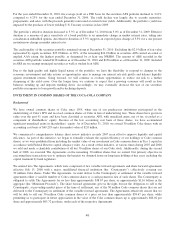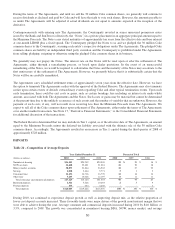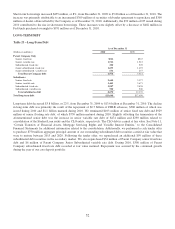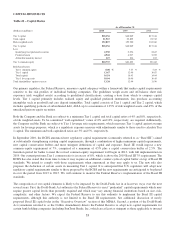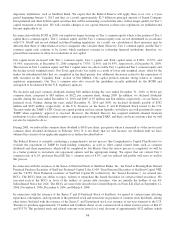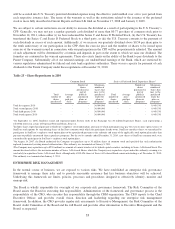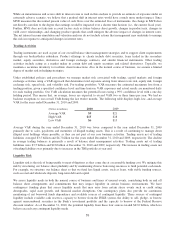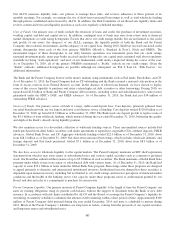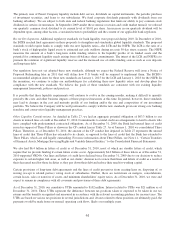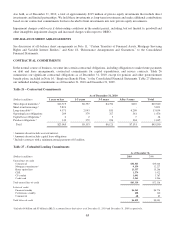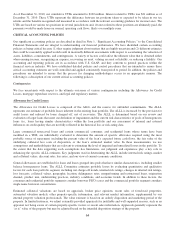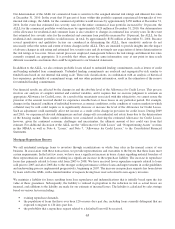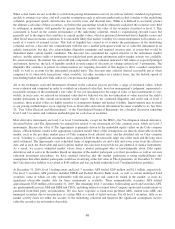SunTrust 2010 Annual Report Download - page 75
Download and view the complete annual report
Please find page 75 of the 2010 SunTrust annual report below. You can navigate through the pages in the report by either clicking on the pages listed below, or by using the keyword search tool below to find specific information within the annual report.
While an instantaneous and severe shift in interest rates is used in this analysis to provide an estimate of exposure under an
extremely adverse scenario, we believe that a gradual shift in interest rates would have a much more modest impact. Since
MVE measures the discounted present value of cash flows over the estimated lives of instruments, the change in MVE does
not directly correlate to the degree that earnings would be impacted over a shorter time horizon (i.e., the current fiscal year).
Further, MVE does not take into account factors such as future balance sheet growth, changes in product mix, changes in
yield curve relationships, and changing product spreads that could mitigate the adverse impact of changes in interest rates.
The net interest income simulation and valuation analyses do not include actions that management may undertake to manage
this risk in response to anticipated changes in interest rates.
Trading Activities
Trading instruments are used as part of our overall balance sheet management strategies and to support client requirements
through our broker/dealer subsidiary. Product offerings to clients include debt securities, loans traded in the secondary
market, equity securities, derivatives and foreign exchange contracts, and similar financial instruments. Other trading
activities include acting as a market maker in certain debt and equity securities and related derivatives. Typically, we
maintain a securities inventory to facilitate client transactions. Also in the normal course of business, we assume a limited
degree of market risk in hedging strategies.
Under established policies and procedures we manage market risk associated with trading, capital markets and foreign
exchange activities using a VAR approach that determines total exposure arising from interest rate risk, equity risk, foreign
exchange risk, spread risk, and volatility risk. For trading portfolios, VAR measures the estimated maximum loss from a
trading position, given a specified confidence level and time horizon. VAR exposures and actual results are monitored daily
for each trading portfolio. Our VAR calculation measures the potential losses using a 99% confidence level with a one day
holding period. This means that, on average, losses are expected to exceed VAR two or three times per year. We had no
backtest exceptions to our overall VAR during the last twelve months. The following table displays high, low, and average
VAR for the years ended December 31, 2010 and 2009.
(Dollars in millions) 2010 2009
Average VAR $9 $21
High VAR $15 $28
Low VAR $6 $15
Average VAR during the year ended December 31, 2010 was lower compared to the year ended December 31, 2009
primarily due to sales, paydowns and maturities of illiquid trading assets. This is a result of continuing to manage down
illiquid asset holdings where possible, as they are not part of our core business activities. Trading assets net of trading
liabilities averaged $3.5 billion and $4.7 billion for the years ended December 31, 2010 and 2009, respectively. The decline
in average trading balances is primarily a result of balance sheet management activities. Trading assets net of trading
liabilities were $3.5 billion and $2.8 billion at December 31, 2010 and 2009, respectively. The increase in trading assets net
of trading liabilities was primarily due to increases in the TRS portfolio at year end.
Liquidity Risk
Liquidity risk is the risk of being unable to meet obligations as they come due at a reasonable funding cost. We mitigate this
risk by structuring our balance sheet prudently and by maintaining diverse borrowing resources to fund potential cash needs.
For example, we structure our balance sheet so that we fund less liquid assets, such as loans, with stable funding sources,
such as retail and wholesale deposits, long-term debt and capital.
We assess liquidity needs in both the normal course of business and times of unusual events, considering both on and off
balance sheet arrangements and commitments that may impact liquidity in certain business environments. We have
contingency funding plans that assess liquidity needs that may arise from certain stress events such as credit rating
downgrades, rapid asset growth, and financial market disruptions. Our contingency plans also provide for continuous
monitoring of net borrowed funds dependence and available sources of contingent liquidity. These sources of contingent
liquidity include available cash reserves, capacity to borrow from the FHLB system, the ability to sell, pledge, or borrow
against unencumbered securities in the Bank’s investment portfolio and the capacity to borrow at the Federal Reserve
discount window. As of December 31, 2010, the potential liquidity from these four sources totaled $43.0 billion, which we
believe exceeds any contingent liquidity needs.
59


